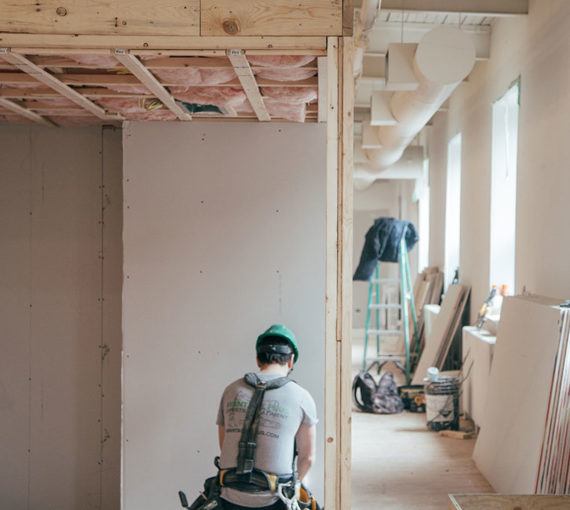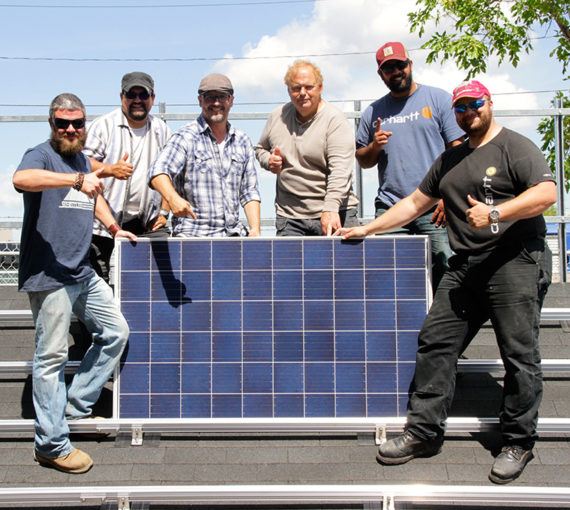
Do you know what goes into a strong climate plan? (Photo: Modern Affliction via Unsplash)
People across Canada are recognizing the threat of climate change, taking to the streets and demanding urgent climate action. Cities and governments are declaring climate emergencies. But what does climate action mean and how can citizens hold governments accountable?
Governments must prioritize actions that experts agree are needed to zero out Canada’s emissions by 2050. Here are the 10 building blocks, supported by science, to take Canada to a zero carbon future.

1. Accelerate clean power
Even though much of Canada’s electricity grid already uses clean sources, provinces and utilities must phase out dirty energy like coal and natural gas. This means cleaning up electricity grids and generating a whole lot more clean power from sources like hydro, wind and solar than we do today. Find out how Clean Power Pathways is collaborating to deliver choices for pathways to diversify our energy mix and meet energy and climate goals.

2. Do more with less energy
Energy savings translate into big climate wins. Canada wastes a lot of energy. The energy performance of new buildings, appliances, vehicles and industrial equipment must be regulated by governments through incentives and restrictions. Saving energy allows Canadians to save money and live more comfortably. Learn how you can save energy.

3. Electrify just about everything
Electricity is Canada’s cleanest energy source for many provinces, but as of 2016 it only powered about 20 per cent of our energy needs. We need to swap out fossil fuels for clean electricity. Studies suggest that by mid-century clean electricity will make up half or more of our energy mix, heating our buildings and powering our vehicles. Electrifying as much as possible by clean energy supports saving energy and will be a pillar of Canada’s efforts to reach zero carbon emissions.

4. Free industry from emissions
Industry can decarbonize the ways it produces things like cement and steel, be more competitive in the zero carbon future and employ more people. Solutions will involve a mix of electrification, carbon capture (trapping carbon from smokestacks), and substituting hydrogen and evolving technologies for fossil fuels.

5. Caution for renewable fuels
There are some instances where transportation cannot be electrified and liquid fuels that are not fossil-based will be needed. This could include biofuels from organic waste streams (e.g., used vegetable oil from restaurants or sawdust) and hydrogen produced with renewable energy. Fuels derived from intact forests or that undermine biodiversity are a false climate solution and should be excluded.

6. Mobilize money
Climate plans must shift money away from carbon-intensive investments toward zero-emissions technologies, generating renewable energy and growing the clean economy. We need to invest in upgrading building efficiency and in our capacity to store energy from renewables.

7. Level the playing field
Governments must send the right price and policy signals to support the energy transition. Steadily increasing the price for polluting supports decarbonizing by 2050 and drives innovation and clean technology. This is one way to “level the playing field” between polluting and cleaner energy. It rewards saving energy, switching to cleaner fuels and making transit improvements.

8. Reimagine our communities
Compact communities have a lower carbon footprint than sprawling highway-dependent suburbs. They prioritize transit and active transportation and support healthier lives. Local governments can use smart city design and land-use policies to build denser communities around transit that lower climate pollution.

9. Focus on what really matters
Prioritizing unlimited economic growth has driven up greenhouse gas emissions. Decarbonizing will be easier if we shift how we measure prosperity away from GDP toward well-being. Then we can focus on innovative ways to live better, with less impact on the climate.

10. Bring everyone along
To ensure the energy transition does not hurt fossil fuel–dependent communities, climate plans must support vulnerable workers. The clean energy transition can be a driver to create more good jobs, invest in upgrading existing jobs, reduce inequality and respond to reconciliation.



